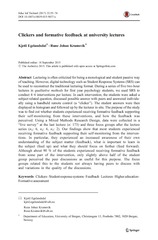| dc.description.abstract | Lecturing is often criticized for being a monological and student passive way of teaching. However, digital technology such as Student Response Systems (SRS) can be used to reconstruct the traditional lecturing format. During a series of five two-hour lectures in qualitative methods for first year psychology students, we used SRS to conduct 4–6 interventions per lecture. In each intervention, the students were asked a subject-related question, discussed possible answer with peers and answered individually using a handheld remote control (a "clicker"). The student answers were then displayed in histogram and followed up by the lecturer in situ. The purpose of the study was to find out whether students experienced receiving formative feedback supporting their self-monitoring from these interventions, and how the feedback was perceived. Using a Mixed Methods Research Design, data were collected in a "live survey" at the last lecture (n: 173) and three focus groups after the lecture series (n1: 6, n2: 6, n3: 2). Our findings show that most students experienced receiving formative feedback supporting their self-monitoring from the interventions. In particular, they experienced an increased awareness of their own understanding of the subject matter (feedback), what is important to learn in the subject (feed up) and what they should focus on further (feed forward). Although about 90 % of the students experienced receiving formative feedback from some part of the intervention, only slightly above half of the student group perceived the peer discussions as useful for this purpose. The focus groups related this to the students not always having peers to discuss with and variations in the quality of the discussions. | en_US |

